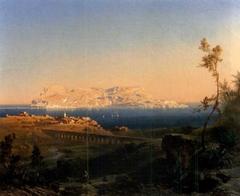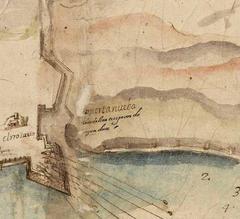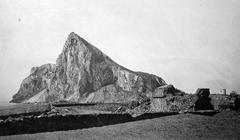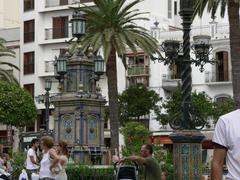
Port of Algeciras Visiting Guide: Tickets, Hours, and Essential Tips
Date: 03/07/2025
Introduction
The Port of Algeciras, strategically located at the southern tip of Spain near the Strait of Gibraltar, is one of Europe’s most significant maritime gateways. With deep historical roots dating back to prehistoric settlements, the port has evolved through Phoenician, Roman, Islamic, and modern eras to become a global leader in shipping, trade, and sustainability. Visitors are drawn not only by its economic vitality but also by its rich cultural heritage, accessible historical sites, and the stunning natural beauty surrounding the Bay of Gibraltar.
This guide delivers detailed information on the port’s history, visiting hours, ticketing, top attractions, sustainability initiatives, and practical travel tips. Whether you are planning a ferry crossing to North Africa, seeking panoramic viewpoints, or exploring Algeciras’ vibrant historic quarters, this resource will help you make the most of your visit.
For official updates, event schedules, and ticketing, consult the Port of Algeciras Authority and leading tourism platforms (Wikipedia; ExpoAlgeciras; Visit-Andalucia; SamAlgeciras).
Historical Overview
Ancient and Medieval Foundations
Archaeological finds around Algeciras reveal human activity dating from the Paleolithic era, with early trade settlements established by the Phoenicians as early as 1,100 BC (ExpoAlgeciras). The Romans subsequently developed the port city of Iulia Traducta in the 1st century CE, making it a commercial hub connecting the Mediterranean (VisitingCadiz).
Following the Islamic conquest in 712 AD, Algeciras became Al-Yazirat Al-Hadra, the first Arab city on the Iberian Peninsula. Its location made it a crucial link for maritime routes between Europe and North Africa. The city thrived during the Middle Ages, enduring several sieges due to its strategic importance. In 1379, pressure from Christian conquests led to its destruction and centuries of abandonment (Visit-Andalucia).
Modern Revival and Port Expansion
Algeciras experienced a renaissance in the 18th century as refugees from Gibraltar resettled its ruins, driving urban renewal and the gradual development of port facilities. The 19th century brought industrialization, the arrival of the railway, and new docks—transforming the port into a regional trade powerhouse (EverythingExplained; PortusOnline).
The 20th century saw rapid urbanization, particularly after 1964, with the establishment of oil refineries, steel mills, and modernization of port infrastructure (Visit-Andalucia). The port’s significance grew as it became a vital node for trade between Europe, Africa, and Latin America, especially during periods of geopolitical tension with Gibraltar (Andalucia.com; Nomads-Travel-Guide).
Contemporary Global Hub
Today, the Port of Algeciras ranks among Europe’s busiest and most advanced ports. It handles millions of tonnes of cargo, serves as a primary European gateway to North Africa, and is recognized for its innovation in sustainable port management (SamAlgeciras; TurboInternacional). Recent urban projects, such as the Lago Marítimo, further integrate the port with the city’s cultural and educational life (PortusOnline).
Visitor Information
Visiting Hours and Tickets
- Port Access: The Port of Algeciras is primarily operational, with restricted access to cargo areas. However, passenger terminals and public areas are open daily, typically from 6:00 AM to midnight, aligned with ferry schedules.
- Ferry Tickets: Purchase tickets for crossings to Ceuta, Tangier Med, or the Canary Islands online, at the terminal’s ticket offices, or through authorized agencies. Advance booking is recommended, especially in peak seasons (Trasmediterranea; Balearia).
- Museums and Historical Sites: Most museums and heritage sites are open from 10:00 AM to 6:00 PM; check individual sites for seasonal variations. Entry fees are modest, and some sites offer free admission.
Accessibility and Transport
- By Train: Algeciras railway station connects to major Spanish cities. The port is ~4 km from the station, with taxis and buses available.
- By Car/Taxi: The port is 10 minutes from the city center, with ample parking.
- Public Transport: Regional buses serve the port area; local routes connect to key urban attractions.
- Accessibility: Terminals and public areas are equipped with ramps, elevators, and signage for travelers with reduced mobility.
Top Attractions and Photographic Spots
- Waterfront Promenade: Capture panoramic views of the port and Bay of Gibraltar.
- Mirador del Estrecho: A renowned viewpoint overlooking the Strait of Gibraltar.
- Plaza Alta: The heart of Algeciras, celebrated for its tilework, fountains, and historic events.
- Archaeological Park of the Merinide Walls: Explore fortifications and learn about Phoenician and Moorish legacies.
- Chapel of Our Lady of Europe & Church of Our Lady of Palma: Key sites reflecting the city’s religious and maritime heritage.
- Los Alcornocales Natural Park: A vast reserve ideal for hiking and wildlife watching.
- Nearby Beaches: Playa de Getares and Playa del Rinconcillo for sunbathing and local cuisine.
Guided Tours and Family Activities
- Guided City Tours: Several operators offer tours focusing on maritime history, architecture, and panoramic viewpoints.
- Maritime Festivals: Seasonal events in and around the port highlight Andalusian culture.
- Bahía Park Water Park: A top choice for families, featuring pools and slides.
Gastronomy and Local Markets
Sample Andalusian specialties such as fresh seafood and espeto de sardinas. Local markets near the port offer authentic flavors and a lively atmosphere.
Sustainability Initiatives
Environmental Commitments
The Port of Algeciras is at the forefront of sustainable port management:
- Green Strategy: Focuses on reducing energy use, carbon emissions, noise, and water pollution, and promoting alternative fuels like LNG and green hydrogen (APBA Environmental Policy).
- Dock Electrification (Onshore Power Supply): Ships can use shore power at dock, drastically reducing emissions and noise (SAM Algeciras Sustainability).
- Renewable Energy: Investments in solar power and energy-efficient infrastructure are ongoing (ExpoAlgeciras Sustainability).
- Smart Port Innovations: Digital platforms optimize vessel traffic, logistics, and environmental monitoring (PortXchange).
- Waste Management: Comprehensive recycling, hazardous material management, and wastewater treatment standards (ExpoAlgeciras Environmental Sustainability).
- Habitat Protection: Ongoing wildlife monitoring and habitat restoration (ExpoAlgeciras Sustainable Development).
- Community Projects: The Lago Marítimo Project will add green spaces and cultural venues, benefiting residents (PortusOnline Lago Marítimo).
Economic Impact and Future Development
- Cargo Throughput: In 2024, the port handled 103.6 million tonnes of cargo and 4.7 million TEUs, with over 10 km of quays and specialized terminals.
- Passenger and Vehicle Traffic: Over 6 million passengers and 1.3 million vehicles crossed through the port in 2024, mainly to North Africa.
- Transshipment Hub: Major shipping alliances use Algeciras for redistribution between continents, especially on the Asia–Northern Europe axis.
- Industrial Ecosystem: The port supports a robust industrial zone, providing thousands of jobs.
- Expansion Plans: Projects include terminal upgrades, deeper berths, and improved connectivity with road, rail, and maritime networks (ExpoAlgeciras Expansion Plans).
- Smart Port Transformation: Ongoing digitalization and AI implementation are increasing efficiency and sustainability (Port of Algeciras Smart Port).
- Urban Integration: The Lago Marítimo Project will create eight hectares of multifunctional green space (PortusOnline Lago Marítimo).
Frequently Asked Questions (FAQ)
Q: What are the Port of Algeciras visiting hours?
A: Passenger terminals operate from approximately 6:00 AM to midnight; check with your ferry operator for specifics.
Q: How do I buy ferry tickets?
A: Purchase online through official ferry operators (Trasmediterranea, Balearia), at ticket offices, or through authorized agencies.
Q: Is the port accessible for travelers with disabilities?
A: Yes, the port provides ramps, elevators, accessible signage, and assistance services.
Q: Are guided tours available?
A: Operational port tours are restricted, but guided city and maritime history tours are widely available.
Q: What are the main nearby attractions?
A: Plaza Alta, Merinide Walls, beaches, Los Alcornocales Natural Park, and the Old Town.
Plan Your Visit and Stay Connected
For the latest updates on visiting hours, tickets, guided tours, and sustainability projects, visit official ferry operator sites and the Port of Algeciras Authority. Download the Audiala app for real-time updates, interactive guides, and exclusive travel tips. Follow us on social media for news and special offers.
For enhanced trip planning, consult interactive maps and multimedia resources highlighting the port’s facilities, historical sites, and green initiatives. Ensure alt tags include “Port of Algeciras visiting hours,” “Algeciras port tickets,” and “Algeciras historical sites” for accessibility and SEO.
Summary and Final Tips
The Port of Algeciras is a dynamic intersection of history, innovation, and sustainable growth. Visitors can immerse themselves in its ancient roots, explore modern maritime operations, and enjoy the cultural and natural riches of the city and region. While operational areas are restricted, numerous viewpoints, historical sites, and engaging tours provide memorable experiences.
Ongoing expansion and environmental initiatives ensure that Algeciras remains a leader in global port operations and sustainability. For a seamless trip, check official resources for schedules and updates, and consider using the Audiala app for personalized guides.
Sources and Further Reading
- Wikipedia: History of Algeciras
- ExpoAlgeciras: Exploring the History and Importance of Algeciras Port
- VisitingCadiz: Algeciras, Gateway to the Mediterranean
- Visit-Andalucia: Guide to Algeciras
- PortusOnline: The Port of Algeciras from the City’s Renaissance to the Present Day
- TurboInternacional: Port of Algeciras, The Gate to Europe
- EverythingExplained: History of Algeciras
- Andalucia.com: Algeciras Home
- Nomads Travel Guide: Algeciras City Guide
- SamAlgeciras: The Port of Algeciras at the Epicentre of World Maritime Connectivity
- Port of Algeciras Authority: Visiting Hours, Tickets, and Sustainability Initiatives
- APBA Environmental Policy: The Environment
- SAM Algeciras Sustainability: Steps Towards Sustainability
- ExpoAlgeciras: Port Expansion Plans
- PortusOnline: The Lago Marítimo Project
- IDOM: Strategic Plan for the Port Authority of the Bay of Algeciras
- Limaniprovisions: Best Places in Algeciras





